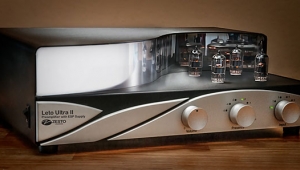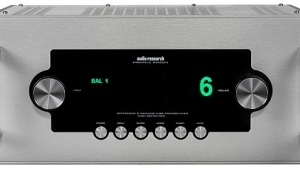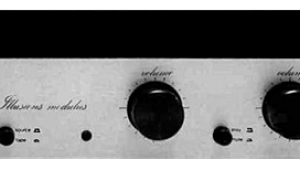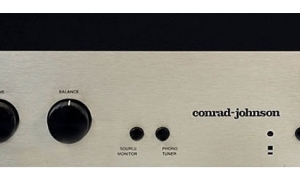| Columns Retired Columns & Blogs |
Conrad-Johnson ART Preamplifier Measurements
Conrad-Johnson's ART preamp offers only single-ended operation, and, as expected from a design with a single gain stage, the output is in inverted polarity. The ART's input impedance (at 1kHz) averaged 12.5k ohms (slightly higher in the right channel, slightly lower in the left), which is high enough not to give source components any drive difficulties. Its output impedance varied somewhat depending on channel and frequency, but it remained in the specified 500 ohm region over most of the band. At 20Hz, however, it rose to 1140 ohms, which means that with power amplifiers offering a low input impedance, such as the Rowlands or various "professional" designs, there will be premature bass rolloff. There should be no matching problems as long as the amplifier input remains above 10k ohms.
The dual-chassis design renders crosstalk measurements meaningless, so none are shown. Signal/noise ratios were acceptably low, though the preamp was not deathly quiet. With its inputs shorted and its volume control set to its maximum of "99," the ART's S/N ratio varied from 57dB (wide bandwidth, unweighted) to 72.5dB (A-weighted), both figures referenced to a nominal 1V output. Reducing the volume control to the unity-gain setting of "66" gave a 7dB improvement in the unweighted figure and a 20dB improvement in the A-weighted reading, suggesting that most of the noise comes from before the volume control and is outside the audio band.
The volume control appeared to work in steps of approximately 0.8dB, with "66" being the unity gain setting. "99" was equivalent to gains of 25dB (left channel) and 24.76dB (right). In practice, the volume control will be used at settings below unity gain, except with very insensitive amplifiers. Without feedback, the preamplifier's channel matching is at the mercy of the tubes used: there was a consistent level mismatch of almost 0.5dB between the ART's channels; this could not be adjusted by the balance control, due to its discrete steps. Setting both channels to "66" gave the 0.5dB mismatch; reducing the right channel to "65" now gave a level mismatch of 0.2dB in the other direction.
This channel imbalance can be seen in fig.1, which shows the ART's frequency response at 1V output into both an optimal 100k ohm load and an atypically low 600 ohm load, with its volume control set to unity gain. At low frequencies the response into 100k ohms is flat down to the 10Hz limit of the graph, but into 600 ohms the bass rolls off below 100Hz, as expected from the output impedance measurement. I was worried that paralleling 10 triodes would give a reduced bandwidth due to the adding of the tubes' parasitic capacitances. At high frequencies, however, the preamp is flat into either load up to 20kHz, and there is actually a slightly earlier ultrasonic rolloff into the kinder load. There was also some dependence of the preamp's HF bandwidth on the volume-control setting: Increasing the level setting to "99" and reducing the input drive to keep the output voltage the same into the 100k load rolled off the highs to -1dB at 20kHz. In practice, the ART will never be used with the volume control set this high, rendering the measurement moot.
Despite the ART's complete absence of negative feedback, whether loop feedback or local degeneration, it is a very linear design. Fig.2 shows the THD+noise percentage plotted against frequency at 1V into 100k ohms and 600 ohms. Into the higher impedance, the distortion remains below 0.15% across the band. Reducing the load to the punishing 600 ohms raises that figure to 0.4%, but it remains constant with frequency. And because the distortion spectrum into either load (figs.3 and 4) consists almost entirely of the benign second harmonic, the subjective effect of this residual nonlinearity should be minimal.
Of course, as there is no feedback, the level of the distortion will depend very much on the output level. The question is, has Conrad-Johnson's design team optimized the circuit's behavior for typical levels and loads?
How the distortion percentage changes with output voltage, again into both 100k and 600 ohm loads, is shown in fig.5. Into 100k ohms, and at levels below 1V, the preamplifier appears to be astonishingly linear considering its single-ended design and lack of negative feedback. At 300mV output---a typical cruising level for classical music with a typical amplifier and loudspeaker combination---the measured distortion is just 0.065%!
The fact that the ART has been optimized for real-world conditions is confirmed by fig.6, plotted with the Amplifier Profiler from Miller Audio Research. I used a 1kHz toneburst signal (10 cycles on, 400 cycles off), which will be more representative of the preamp's performance with music. The black area shows the distortion floor plotted against output voltage with the preamplifier driving the optimal 100k ohm load. Reducing the load to 10k ohms, which is typical of many power amplifiers, gave only a small increase in distortion (red trace). And with the range of output voltages typical of real-world use, indicated to the left of the vertical green line, the distortion into either 100k or 10k is acceptably low. Only above 4V or so into the higher impedances, or at lower voltages into an atypical 1000 ohm load (blue trace), does the ART's lack of feedback manifest itself as probably audible levels of distortion. And it is almost 100% unlikely that the preamp will ever be subject to these conditions.
Other than the trivial level mismatch between channels, the Conrad-Johnson ART's measured performance offers no clues to its esoteric design. And its performance envelope is well suited to the conditions it will be asked to endure. Now if only I could wrest it from WP's system and try it in my own for a while! ÷ John Atkinson
- Log in or register to post comments




































